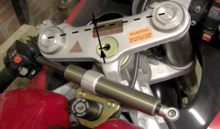Triple clamp offset
The triple tree offset is the distance between the center of the steering head and the plane of the axes of the stanchions on telescopic forks .
In the fork bridge , the mounting holes for the stanchion tubes of the telescopic fork and the hole for the steering head are not on the same level, but the steering head is - seen in the direction of travel - offset slightly backwards. The usual “offset” for all modern motorcycles is between 25 and 40 mm. With the triple clamp offset, the manufacturer can fine-tune the chassis geometry. A larger triple clamp offset results in a larger wheelbase and slightly less caster with the same steering head angle .
A difference between the upper and lower bridge creates the so-called "stretched fork bridge"; this allows the overrun to be shortened or lengthened.
"The different combinations of triple clamp offset and steering head angle determine the caster."
literature
- Gaetano Cocco: Pure motorcycle technology. Motorbuch Verlag Stuttgart, 1st edition 2001, ISBN 3-613-02127-7
Web links
Individual evidence
- ^ A b Ulrich Hoffmann : The great motorcycle lexicon. For beginners, connoisseurs and experts. Schwarzkopf & Schwarzkopf Verlag, Berlin, 2004, ISBN 978-3-89602-535-7 , p. 281
- ↑ Cocco, p. 25.
- ↑ Thomas Ihle: Motorcycle technology for beginners. BoD Norderstedt 2007, ISBN 978-3-8370-0488-5 , p. 25.
- ↑ Cocco, p. 25.
- ↑ motorrad-gespanne.de fork bridge (accessed on October 2, 2013)
- ↑ motorrad-gespanne.de caster shortening (accessed December 9, 2014)

